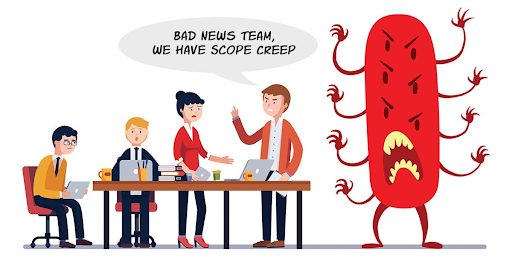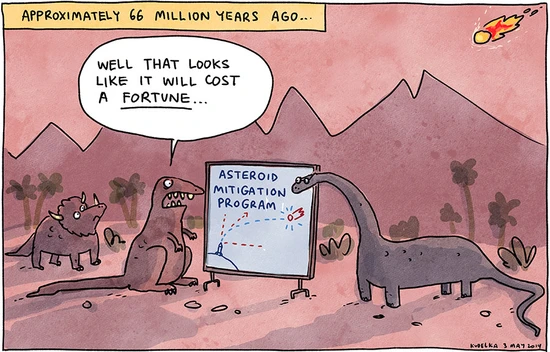Ever since the dawn of project management, scope creep has always crept into projects, plaguing businesses and employees alike. It's a challenge that every project faces and it's a challenge that must be controlled and addressed when it arises.
Scope creep that isn't controlled has the potential to cause the project size and costs to blow out and up, putting more financial strain on a business and more pressure on its employees.
The first step to understanding scope creep is to understand the beginning of the process and defining your project scope.
What is Project Scope?
When you start a new project, project managers, executives, and anyone else who needs to be involved, sits down to discuss everything and anything that'll be involved with a project; this is the project scope. This involves defining goals, tasks, deliverables, deadlines and expectations around what is needed from all parties involved, as well as a definition of what is and what is not part of the project.
So when does scope creep occur?
As per Wikipedia, scope creep is defined as the following:
Scope creep in project management refers to changes, continuous or uncontrolled growth in a project’s scope, at any point after the project begins. This can occur when the scope of a project is not properly defined, documented, or controlled. It is generally considered harmful.
Even when you have a clearly defined project, it's very easy for additional tasks to creep in. Investors, stakeholders, or clients want additional changes and new features added to product designs that have already been approved, without providing equivalent increases in budget, time and/or resources.

So what are some examples of scope creep and how do they occur?
1. Rework from Lack of Clarity
During the initial phases of discussing the project, a lack of a clearly defined brief with no depth and clear direction is only going to lead to one thing - creep. If a designer, developer, marketer, copywriter or whoever it may be is following a loose brief, it's only going to lead to reworking and multiple changes.
Now, of course changes are inevitable, but it's about giving project team members proper direction from the start, limiting unnecessary changes.
2. Unmanaged Contact with Client
We all know what happens when a client has direct contact between themselves and a team participants; a hundred and one little changes and requests start to pop up, slowing everything down and adding extra work to a team.
Having one point-of-contact between a business and a client to validate the request and make the call on whether it's necessary will help to keep the working process streamlined and on track.
3. Investment in the wrong areas
If you begin a project without doing a proper cost-benefit analysis, you may as well invite scope creep in with open arms. By not knowing where you should and shouldn't invest your time and money,. You don't want to get half-way through a project and realise you should have invested in something else or vice-versa.

4. DIY Mentality
If there's a lack of foresight and proper planning, things will get missed when defining the project. Down the track, problems and extra tasks will jump up and cause people to 'do it themselves' to get it out of the way.
5. Over Promise
It's a classic case of sales over-promising and breaking the backs of delivery to get the project over the line. By not including all the necessary people in the conversation when pitching to a client, you're opening the door for clients to have higher expectations than what's deliverable.
Scope Creep Doesn't Always Creep from Outside In
It's worth noting that scope creep ins't always the results of a client and stakeholder wanting changes. No, scope creep can occur internally. A team will be busy at work, working towards their deadline and someone from a different department may slide over and approach you with a 'little job'.
In cases like this, have to ask the questions "Is this request of the utmost importance and more important than what I'm currently working on?" and "If so, are you happy to communicate to the client why this was moved out?".
By asking these two questions, you can normally come to a pretty quick solution.
Avoiding Scope Creep
Before we look at ways of minimising scope creep, we should preface this by saying scope creep is going to happen. It's not completely unavoidable. It's about staying on top of it, remaining agile and making sure it doesn't completely derail the project.
One of the best things you can do to limit the amount of scope creep - and the answers simplicity may surprise you - is to simply say no. It's one word that can change everything.
Now, it's not a case of simply saying 'no' to a request. That would be rude. Saying no is a subtle art. What you want to do is start with a 'yes' when actually saying 'no'. Let's take a look:
- “Yes we do offer this service, but unfortunately it’s not part of your current scope. Would you like me to put you in touch with a sales rep to discuss your options”
- “Yes we do capture that data, and it’s available to you here. For security reasons we can’t export it and email it through to you as protecting your data security is our number one priority.”
- “Yes it’s possible to do that, but dropping what we are currently working on to do that would set your overall project back by two weeks, Is that acceptable to you?”
Project Management
The next thing you can do to significantly help stay on top of your scope creep, is effectively managing your project through the use of a workflow management system, like monday.com.
Monday.com allows teams to plan, organise, execute and track day-to-day work, comprising of workflows, projects, initiatives, epics, and tasks. In essence, a work flow management tool can allow you to take full ownership of a project with complete visibility of everything that needs to be done.
The purpose of this is to help efficiency with the completion of tasks, offering transparency with all users involved and encouraging, if needed, collaboration within departments to complete work.
Through this transparency, a team knows exactly how much scope creep they can cater to and how much they can't, allowing for a clear and justified responses to clients, stakeholders, or even fellow colleagues.




Comments